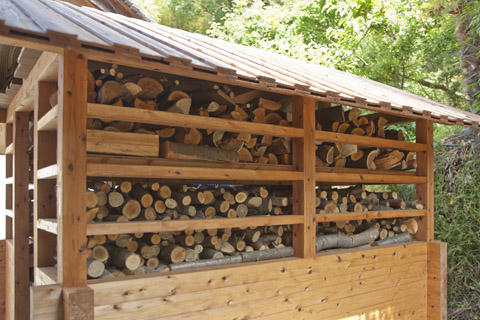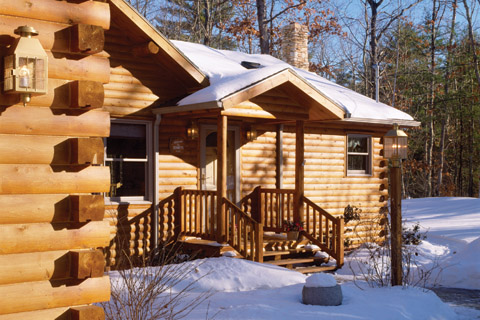For log and timber homeowners, the maintenance mantra is simple: Take care of the basics. Taking advantage of some advice from experts Tony Huddleston of Perma-Chink Systems and Scott McCain of Mountain Home Building Products, even maintenance dummies will go to the head of the class.
Start with the basics. Take a walk around your home at least twice a year. It will help you get acquainted with your home’s exterior and give you an opportunity to check the sealants and finishes.
Pay particular attention to the sealing systems around windows and doors. Checking and fissure development is a naturally occurring process in large timbers. Make note of any checks that face upward and may catch water and hold moisture. These should be filled with a waterproof sealant.
Look for telltale signs that your stain or finish is beginning to need attention. Fading, peeling, or dark areas under the finish are good indicators that it is time for a maintenance coat.
Typically, the southern exposure of your home will require some maintenance every two to three years, and the other sides will need attention every three to five years. Use quality products. The old adage, “You get what you pay for!” is quite relevant in the finishing products business.
The south and west sides of the home tend to catch most of the sun and its damaging ultraviolet rays. Remember, though, it isn’t always necessary to restain the entire home. Sometimes a touch-up on the weathered sides is just right. Plan on washing the exterior of your home at least once a year to remove all pollen, dirt, and other airborne pollutants that may have settled on the surface. That doesn’t mean that the home has to be pressure washed. A quality wash product and a garden hose will do just fine.
Do not use bleach to wash your log or timber home. Contrary to popular belief, bleach is not a cleaner and is not only potentially harmful to the user but also to the environment and the wood itself.

Patrik Slezak
For new construction, prep the surface of the wood with an orbital sander. Use 60 or 80 grit paper to really open the pores of the wood and promote excellent adhesion of the finish. Although this process may take a little longer, the results are second to none and well worth the investment of time.
Landscaping such as shrubs, bushes, or vines should be trimmed back so it doesn’t interfere with air circulation on the exterior walls of the log or timber home. The walls need good air circulation, and landscaping that is planted too close to the structure will, over time, scuff the finish and introduce moisture to the wood.
To test the integrity of the external wood seal, spray the surface with a little water. If the seal is intact, the water will bead up. If the water penetrates the wood, then it is time for another finish coat.
Remember, it’s easier to maintain wood than to replace it, and a lot less expensive.
Watch for insect activity during your semiannual walk around. Evidence that looks like sawdust may indicate powder post beetles. Tunnels leading from the ground to a base log or lower plate could mean a termite infestation. Carpenter ants do not directly attack the wood but build nests in and around the home. Take action immediately if any of these signs are present.
Store firewood away from the home. Insects love it.
Make sure that exterior drainage is adequate and that water is not allowed to stand along the foundation of the log or timber home.
Consider installing decorative stone in areas where water is allowed to drain or prone to collect. The stone adds a nice look and helps eliminate backsplash effect that can lead to rotten wood.
Contact a professional to inspect the roof of your log or timber home every three to five years. Replacing loose shingles and removing debris will help prevent leaks.

Sukiyaki
Energy conservation is paramount these days, so consider an energy audit of your log or timber home, particularly one that includes a blower door test to pinpoint areas where air enters or leaves the home. Light maintenance can reduce energy bills and cut down on draftiness.
To avoid a flood of regret, minimize the external exposure of water pipes and insulate those that may be prone to freezing during the winter.
Winterize swimming pools or outdoor water features, and place furnishings that could deteriorate due to exposure to harsh weather in storage.
Invest in a semiannual maintenance contract to ensure that heating and air conditioning systems are in peak operating condition from season to season.
Change air conditioning filters at least twice a year to maximize efficiency.
Reseal granite or other stone countertops every three to five years or as needed to maintain high luster.
Energy efficient appliances and light bulbs help the environment.
Check windows periodically to make sure that they are tightly closed for security and energy efficiency.
Consider installing a security system for home protection and peace of mind, particularly when you are away from your favorite place on earth.
To eliminate the buildup of creosote and ensure safe operation, engage a professional to inspect and clean fireplaces annually as autumn arrives.
Create a simple maintenance plan or checklist for your log or timber home and follow it.
This list is not intended to be complete; however, it offers a solid starting point for ensuring years of pleasure and pride of ownership in your log or timber home. Really, the only dummy is the one who doesn’t ask questions, take advantage of expert advice, and practice regular basic maintenance.

